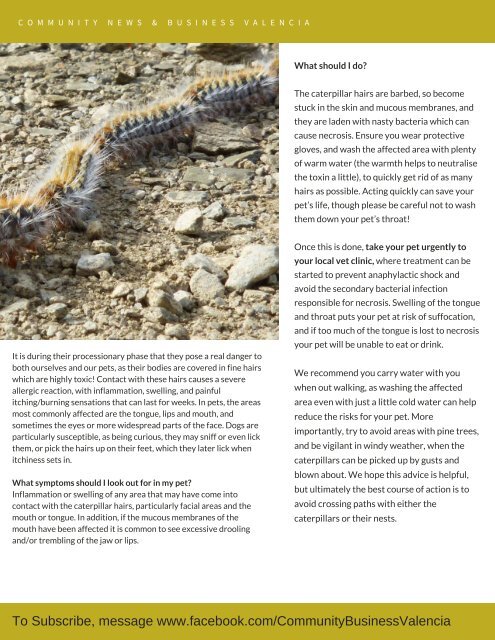Community Spirit, Jan 2019
Community News & Business emagazine was created in 2017 to help bring the English speaking community closer together in the city and the surrounding towns. And to support individuals and businesses to overcome their challenges of setting up a new life in this beautiful area. Don't miss an issue of the emazine magazine! To subscribe and get all the back issues, goto and subscribe under the tab labelled 'Email Signup': /www.facebook.com/CommunityBusinessValencia
Community News & Business emagazine was created in 2017 to help bring the English speaking community closer together in the city and the surrounding towns. And to support individuals and businesses to overcome their challenges of setting up a new life in this beautiful area. Don't miss an issue of the emazine magazine! To subscribe and get all the back issues, goto and subscribe under the tab labelled 'Email Signup': /www.facebook.com/CommunityBusinessValencia
Create successful ePaper yourself
Turn your PDF publications into a flip-book with our unique Google optimized e-Paper software.
C O M M U N I T Y N E W S & B U S I N E S S V A L E N C I A<br />
What should I do?<br />
The caterpillar hairs are barbed, so become<br />
stuck in the skin and mucous membranes, and<br />
they are laden with nasty bacteria which can<br />
cause necrosis. Ensure you wear protective<br />
gloves, and wash the affected area with plenty<br />
of warm water (the warmth helps to neutralise<br />
the toxin a little), to quickly get rid of as many<br />
hairs as possible. Acting quickly can save your<br />
pet’s life, though please be careful not to wash<br />
them down your pet’s throat!<br />
It is during their processionary phase that they pose a real danger to<br />
both ourselves and our pets, as their bodies are covered in fine hairs<br />
which are highly toxic! Contact with these hairs causes a severe<br />
allergic reaction, with inflammation, swelling, and painful<br />
itching/burning sensations that can last for weeks. In pets, the areas<br />
most commonly affected are the tongue, lips and mouth, and<br />
sometimes the eyes or more widespread parts of the face. Dogs are<br />
particularly susceptible, as being curious, they may sniff or even lick<br />
them, or pick the hairs up on their feet, which they later lick when<br />
itchiness sets in.<br />
What symptoms should I look out for in my pet?<br />
Inflammation or swelling of any area that may have come into<br />
contact with the caterpillar hairs, particularly facial areas and the<br />
mouth or tongue. In addition, if the mucous membranes of the<br />
mouth have been affected it is common to see excessive drooling<br />
and/or trembling of the jaw or lips.<br />
Once this is done, take your pet urgently to<br />
your local vet clinic, where treatment can be<br />
started to prevent anaphylactic shock and<br />
avoid the secondary bacterial infection<br />
responsible for necrosis. Swelling of the tongue<br />
and throat puts your pet at risk of suffocation,<br />
and if too much of the tongue is lost to necrosis<br />
your pet will be unable to eat or drink.<br />
We recommend you carry water with you<br />
when out walking, as washing the affected<br />
area even with just a little cold water can help<br />
reduce the risks for your pet. More<br />
importantly, try to avoid areas with pine trees,<br />
and be vigilant in windy weather, when the<br />
caterpillars can be picked up by gusts and<br />
blown about. We hope this advice is helpful,<br />
but ultimately the best course of action is to<br />
avoid crossing paths with either the<br />
caterpillars or their nests.<br />
To Subscribe, message www.facebook.com/<strong>Community</strong>BusinessValencia

















